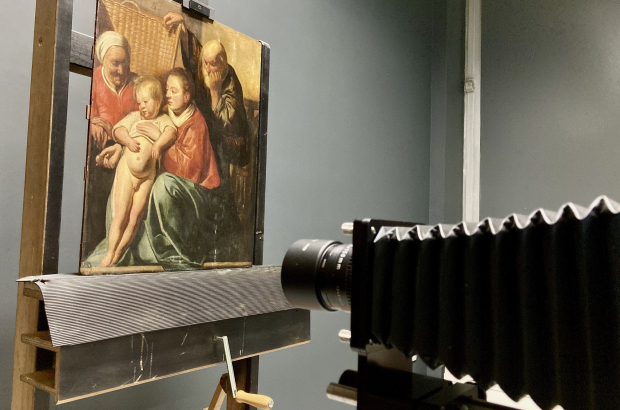- Daily & Weekly newsletters
- Buy & download The Bulletin
- Comment on our articles
Original Jordaens masterpiece found hanging in Saint-Gilles town hall
An inventory of artworks in Brussels has led to a remarkable discovery – a painting hanging in a town hall long assumed to have been a copy is in fact an original by the Flemish master Jacob Jordaens, a contemporary of Rubens and Van Dyck.
Last year, the region asked the Royal Institute for Cultural Heritage (KIK) to catalogue the art in its public buildings. A team catalogued 800 works in the town hall of Saint-Gilles including ‘The Holy Family’, a work depicting the baby Jesus with Joseph, Mary and her mother, Saint Anne.
It had hung in the building for 60 years, in the office of the councillor in charge of town planning. Over that time it had been assessed many times but believed to be a copy. Hanging at a height of three metres, it had likely never been removed from the wall until now.
By analysing the wood panel the work was painted on, experts determined that it is the oldest known version of ‘The Holy Family’. Imaging techniques including X-ray, infra-red, macro XRF, ultra-violet and close-up photography confirmed its provenance. They also found that the wood came from the same tree as that used in works by Van Dyck, reinforcing the theory that the two worked together in Rubens’ studio.
“It is a particularly emotional moment to discover an original work by one of the greatest Baroque painters,” said Constantin Pion, an art historian at KIK. “It is also enormously fascinating to conduct scientific research when it can be shown that this ‘Holy Family’ represents an important milestone in the work of the young Jacob Jordaens.”
Jordaens (1593-1678), a leading Flemish Baroque painter from Antwerp, created the work in 1617 or 1618 aged just 25. There are three other versions, in the Metropolitan Museum in New York, the Hermitage Museum in Saint Petersburg and the Alte Pinakothek in Munich. This discovery confirms that the Brussels painting (pictured below) is older and can be considered the prototype for the other three.
“The painting was thought to be a copy. We took it down off the wall and as soon as we got it down – you didn’t have to be an expert on this 17th-century Baroque painter – we noticed clues,” Pion explains. “Clues that had never been noted or described before. Things like the panel-maker’s marks, or the mark of the City of Antwerp, a kind of seal of approval. That’s exactly what we found on the back of this panel. Such are the joys of the art historian.”
The painting had belonged to Léopold Speekaert, a wealthy painter in Brussels, who left his collection to the municipality when he died in 1915. A museum was opened to house the works, but the running costs forced it to close in 1965, at which point the collection was moved to the Saint-Gilles town hall. It will undergo restoration at the RICH and go on display at Brussels’ Royal Museums for Fine Arts at the end of 2021.
A video by KIK explains how the painting was discovered.
Photos: KMSKB/KIK-IRPA


















